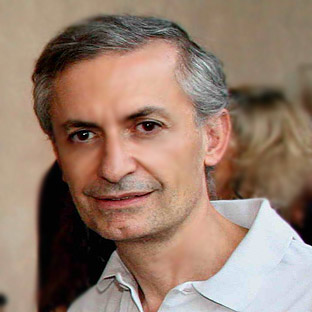In 1999 I made my first solo exhibition at the Luigi Montanarini Cultural Association in Genzano (RM), with critical text of Professor Robertomaria Siena, who commented: Piero Marsili, or the delicacy of the monster.
The unknown has the prodigy and is used to create the Monster
V.Hugo

Prof. Robertomaria Siena
Piero Marsili is a painter of “monsters”, and this is possible if one takes into account that, from the historical avant-garde onwards, the defiguration is predominantly located in the heart of artistic research.
Obviously, “the loss of the centre” and “the death of God” could not favour the rite of the untouched Beauty, the Beauty that in ‘800 had found in Ingres a sublime and invincible magician.
But now it must be immediately revealed that Marsili’s “monsters” are marked by an ethical thickness that prevents them from sharpening their weapons, turning into pointy warheads. They are awkward and huge, so incapable of ferocity; unfit for the bellum omnium contra omnes, they preach the categorical imperative and the “need to be”.
Marsili is not a “kantian”, the ethics that his “monsters” cultivate is not abstract, nor purely Puritan.
It accompanies a human condition that discovers all its fragility and all its contingency.
Monsters are often found in a situation of incommunicability that allows them eloquently to recite the part of man’s metaphors. But it is not over; Constantly Marsili’s “monsters” denounce an abysmal hiatus between the soul and the body. The body, in fact, losing, sagging, a hindrance to beauty; to the extent that we can approach them quietly and we can stay in their company, we find that their soul is beautiful and that the entelechy is very different from the cortex. Luigi Pirandello comes to mind and the painful separation between the deep self and the meat-matter. In one of the “Novels for a year”, a character so confesses: “You see me so fat and maybe you do not believe I can move on to a spectacle of nature. But believe me, I have a soul somewhat mild. A little soul with blonde hair, with a sweet, diaphanous, sharp little face and sky-coloured eyes “.
From here Piero Marsili’s pictorial discourse is essentially linked to a referentialist view of art; in recent works, however, the formalist tradition (molded by the historical avant-garde and confirmed by the neo-avant-garde) tends to take over. The “monsters” tend to lose themselves as men; la defiguration goes fast in the direction of a clear loss of relationship with reality. So antireferencialism demands its part and aims to make itself resolved within its own semantic and conceptual architecture.
We cannot foresee what Marsili’s next move will be; we find ourselves in front of a young artist who loves research and who has engaged in this with a tight and passionate dialogue. But one thing is certain: Piero Marsili will never abandon the soil of painting; the Calvinism inherent in the various forms of conceptualism does not interest him and does not convince him.
Art, for him, therefore is matter, body, sensitivity, physicality; the mind is not disconnected from all this; it is constantly invaded by the flesh and intends to make us fall into the whirl of seduction that has sprouted to our advantage.
Robertomaria Siena, 1999

Prof. Gabriele Simongini
Throughout this period of research there have been times when I rediscovered some colours (yellow, purple, bleu …) and then I returned to the essence of White, Red, Black …
Professor of History of Contemporary Art and Critical Art Gabriele Simongini, whom I met in 2000 during the International Art Exhibition “Premio G. B. Salvi”, Municipality of Sassoferrato, (An), which I attended in 2011, as quoted:
For Piero Marsili, the painting flourishes with a glowing passion, without compromise. And the flame glitters in dazzling, pure, pasty, sometimes shameless and direct colours. A primordial world made by miniature colossus who fight and struggle for their dreams and for their hopes emerges on the background of red and yellow skies.
And everywhere in these works, “love calls colour” as V.V. Gogh liked to say. They are banners for a simpler and more natural humanity, capable of rediscovering forgotten human values.
Marsili deeply believes in the free choice of feeling outdated, disconnected from mania and fashion of a society perennially interconnected with illusory desires.
“We are experiencing an anthropological change – asks Giovanni Sartori – from homo sapiens to homo videns, where the primacy of the image atrophies abstract thinking, so that the democratic ideals of equality and freedom appear to many, empty and blurred? “. Here, Marsili wants to remain a homo sapiens capable of thinking and dreaming of freedom painted, for example, in one of his exhibited works at Sassoferrato. And it’s not a little thing.
Gabriele Simongini, 2011